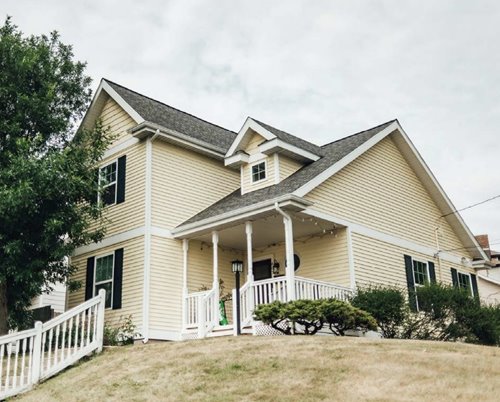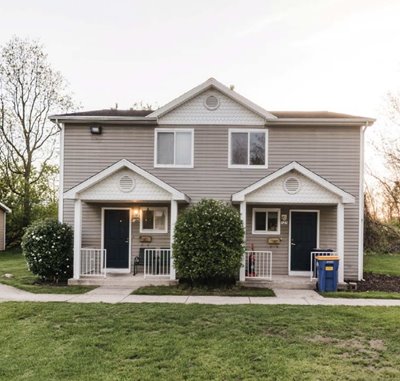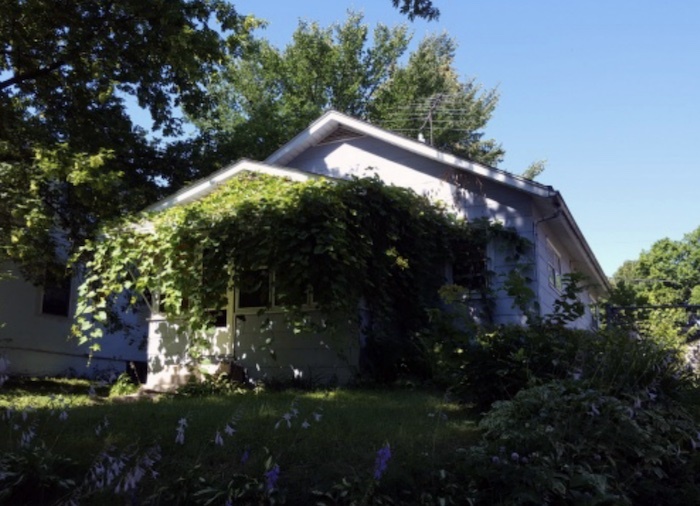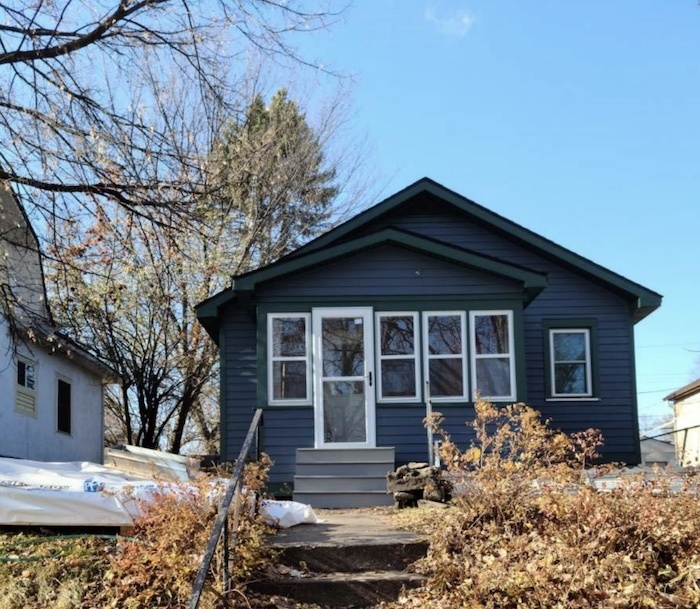Shared equity housing takes the national spotlight this month during NeighborWorks America's symposium, "Shared Equity Housing: Creating Lasting Affordability and Community Ownership" and its second Virtual Training Institute. Shanti Abedin, NeighborWorks' director of Shared Equity Housing, says the organization is focusing on ways to help people think about affordable housing that lasts for generations. Shared equity housing offers a variety of models that share ownership to ensure land and housing stay affordable over time and benefit multiple families.
 "By creating shared ownership, these models give community members who wouldn't otherwise be able to own a piece of their community access to the wealth building and stability that homeownership offers," Abedin says. And it gives homeowners the tools to stay in those homes, too.
"By creating shared ownership, these models give community members who wouldn't otherwise be able to own a piece of their community access to the wealth building and stability that homeownership offers," Abedin says. And it gives homeowners the tools to stay in those homes, too.Models of shared equity housing include entities like community land trusts (CLTs), nonprofit organizations that create homes or businesses to remain permanently affordable by maintaining community ownership of the land and selling the individual houses on it. Homeowners are able to build equity and wealth.
To encourage shared equity housing, NeighborWorks provided $50,000 planning and innovation grants to seven organizations that are finding new models for their communities. While some of the organizations are using the grants to continue their work in the shared equity field, Dwelling Place of Grand Rapids Nonprofit Housing Corporation is using its planning grant to enter the field.
Dennis Sturtevant, CEO of Dwelling Place, says his organization tried a community land trust once before, in 2008. But they opted to not to create a start-up CLT in the middle of the recession. They sold the nine properties they'd acquired to rehab for the trust to Habitat for Humanity of Kent County.

In 2015, though, Dwelling Place, known for its affordable rentals, became a NeighborWorks member. Now, the organization is using NeighborWorks resources and other funding to help support a new community land trust in Grand Rapids – and more. Sturtevant hopes the model, which will take advantage of brownfield Tax Increment Financing (TIF) to fill development gaps for newly constructed units, will be used throughout Michigan, especially among NeighborWorks organizations. It's a blueprint that can work for both urban and rural areas in Michigan, he says.
NeighborWorks' help to Dwelling Place was twofold. First, a grant allowed the organization to consult with Michael Brown of Burlington Associates, an authority on community land trusts, as they put together their application to form a 501c3 entity, articles of incorporation, and other ownership and leasing documents required for their land trust. Second, it allowed the organization to form a business plan for the construction of new homes and a program to take several of its smallest rental projects and convert them to homeownership. The rental conversion units include six duplexes and 23 apartments, along with 10 single-family homes for a total of 45 units.
Dwelling Place has a lot of equity in those rental properties. The plan is to use money from the sales of the units to community land trust owners to pay for the start-up of the community land trust, along with renovations. "We've set aside $750,000 to fund our CLT operations with an operating and loss replacement reserve," Sturtevant. "Creating the operating reserve allowed us to focus on fundraising for CLT technical assistance and filling gaps in development for new units rather than staff costs until our CLT is sustainable."
 One of the problems CLTs have had in the state, he says, is that there isn't a single source of financing to cover "the gap" created when selling a new home for 75% of its appraised value. Most CLTs require at least some philanthropy to cover what can often be a substantial gap, and that means creating only two or three homes at a time. But the need for affordable housing is great, he says, and by experimenting with using Brownfield TIF with new units and moving existing rental properties with little debt to the trust, they're creating a model to create multiple CLT homes at once. Key to this, too, is Michigan's Brownfield Act, which allows municipalities to develop and implement "Brownfield projects," using TIF as a tool to redevelop properties. In other words, the CLT will be able to monetize property taxes paid by homeowners to help alleviate the gap. With a smaller financial gap, he says, they could do 30 homes at a time instead of three.
One of the problems CLTs have had in the state, he says, is that there isn't a single source of financing to cover "the gap" created when selling a new home for 75% of its appraised value. Most CLTs require at least some philanthropy to cover what can often be a substantial gap, and that means creating only two or three homes at a time. But the need for affordable housing is great, he says, and by experimenting with using Brownfield TIF with new units and moving existing rental properties with little debt to the trust, they're creating a model to create multiple CLT homes at once. Key to this, too, is Michigan's Brownfield Act, which allows municipalities to develop and implement "Brownfield projects," using TIF as a tool to redevelop properties. In other words, the CLT will be able to monetize property taxes paid by homeowners to help alleviate the gap. With a smaller financial gap, he says, they could do 30 homes at a time instead of three.Meanwhile, Dwelling Place is working on a grant with Spectrum Healthier Communities that, if funded, would allow them to offer down payment assistance to some of the lowest income renters hoping to become homeowners in the in the 45 CLT rental conversion units and fill the development gap on at least 30 newly constructed CLT single family homes.
"We have not built a single new CLT house yet," Sturtevant says. "But I think we'll be able to offer a model of how to scale this up. Because of the Brownfield statute, I think CLTs could become a major part of the housing industry in Michigan. We don't want it to just work in Grand Rapids; we want it to work anywhere in the state."
David DeVelder, CLT director for Grand Rapids, has been working with Dwelling Place since May. His hope is to get the first home being converted from rental to homeownership, locked in and sold this month, to a single mother with three children. "We're off to a great start," he says.
He's spent most of these last months educating renters and conducting a CLT orientation. If they don't want to buy, or can't qualify, residents are allowed to continue renting as long as they want. But when they move on, the home will move to the sales side. The CLT has a provision for no-cost representation through the local bar association, to make sure the buyers have their own legal counsel and support as the CLT moves forward.
The education aspect is important, DeVelder says. Not only are residents new to land trusts, many of them are new to homeownership. Habitat Michigan is helping with the education and helping residents move on to mortgage approval. During COVID-19, the education has been virtual, sometimes with families gathered around a cell phone to listen.
Sturtevant says they don't want residents to buy if they aren't ready. "But we don't want fear or a lack of information about homeownership to be a barrier in becoming a homeowner." When people hear that they can purchase a home for 75% of its appraised value, he says, he expects the interest to grow. Meanwhile, the organization is making a concerted effort to reach out to communities of color to make sure they know about the opportunity and have an equal chance of taking part.
DeVelder says so far, he's been able to present his orientation to half of the current renters. When they see the closings, he says, he expects more people will get in line.
The innovation grant from NeighborWorks allows Dwelling Place to pay for technical assistance, legal fees and other soft costs. "It put things in motion," DeVelder says. It also allows the organization to leverage other dollars such as the $100,000 grant they received from Downtown Grand Rapids Inc. and the $10,000 grant they received from Huntington Bank, all key to starting a project like this.
Keeping homeowners in their homes
The City of Lakes Community Land Trust (CLCLT) offers would-be homeowners a path to affordable homeownership. And now, in partnership with NeighborWorks Home Partners, the organization is giving people on the brink of losing their homes a chance to keep them.
CLCLT began as a standalone land trust in 2002, with its first buyers in 2004. Jeff Washburne, now director, was the first hire. Today, the Minneapolis land trust is believed to be the third largest in the nation. Over the past 12 years, the organization has built or acquired just over 320 homes. But every now and then, says Washburne, the organization would get a call from homeowners who were about to lose everything.

"It's a pretty atypical approach for affordable homeownership," Washburne says. But each week, he gets at least three phone calls from around the country asking about it. As residents are financially affected by COVID-19, he says, he expects more people to reach out and need help restructuring their loans and debt issues, which is why they've formalized the program. Washburne says he hopes to add 10 new homes to the housing trust this year.
The city and county are on board with the idea, says Washburne, who will talk about his plans during a VTI symposium panel next week He still hopes to convince the state that it's an idea worth investing in, which is a reason that innovation grants, like the one from NeighborWorks, are so effective. "Every dollar we raise builds credibility," he says. "It signals to other funders that this is something that makes sense."

The land trust began working with NeighborWorks Home Partners five years ago. Each organization stuck to its expertise. When CLCLT acquired a new loan portfolio through a merger, they asked NeighborWorks Home Partners to originate the loans. NeighborWorks Home Partners, meanwhile, had acquired a few land trust units. They contracted with CLCLT to administer that portfolio. The organization has office space in the same Minneapolis building for homebuyer education and counseling, so the two organizations were in constant communication and referred clients back and forth.
When the possibility came to work together in a more formal way on the shared equity project, they already had the foundation. The program is continuing as a pilot program called the Sustained Legacy Project. A program like this, Washburne says, is long overdue.
Register for the VTI here.

